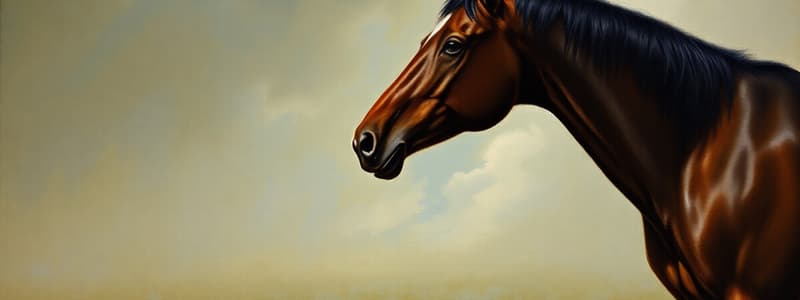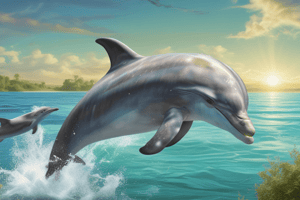Podcast
Questions and Answers
Horses are valued for providing essential labor in some regions.
Horses are valued for providing essential labor in some regions.
True (A)
Horses do not require regular veterinary care for their health.
Horses do not require regular veterinary care for their health.
False (B)
A horse's gestation period lasts about 11 months.
A horse's gestation period lasts about 11 months.
True (A)
The lifespan of a horse is unaffected by environmental conditions.
The lifespan of a horse is unaffected by environmental conditions.
Proper nutrition is important for the health and longevity of horses.
Proper nutrition is important for the health and longevity of horses.
Horses belong to the taxonomic family Canidae.
Horses belong to the taxonomic family Canidae.
The average height of a horse typically ranges between 14.2 and 17 hands high.
The average height of a horse typically ranges between 14.2 and 17 hands high.
Horses have a three-chambered heart.
Horses have a three-chambered heart.
Horses are social animals that often live in herds.
Horses are social animals that often live in herds.
The evolutionary history of horses shows a transition from larger, multi-toed ancestors to smaller, single-toed horses.
The evolutionary history of horses shows a transition from larger, multi-toed ancestors to smaller, single-toed horses.
Humans have used horses for agriculture and transportation for thousands of years.
Humans have used horses for agriculture and transportation for thousands of years.
Horses cannot learn or remember tasks.
Horses cannot learn or remember tasks.
Selective breeding has resulted in different breeds of horses with varying physical characteristics.
Selective breeding has resulted in different breeds of horses with varying physical characteristics.
Flashcards
Horse Health Issues
Horse Health Issues
Horses are prone to different health issues, including problems with their muscles and bones, digestion, breathing, and catching infections.
Optimal Horse Health
Optimal Horse Health
Providing the right food, regular physical activity, and preventive measures are essential for horses to stay healthy and live longer.
Horse Gestation Period
Horse Gestation Period
A horse's pregnancy lasts about 11 months.
Horse Breeding Strategies
Horse Breeding Strategies
Signup and view all the flashcards
Influences on Horse Lifespan
Influences on Horse Lifespan
Signup and view all the flashcards
Describe the body shape of a horse.
Describe the body shape of a horse.
Signup and view all the flashcards
What are some common horse coat colors?
What are some common horse coat colors?
Signup and view all the flashcards
How do horses live socially?
How do horses live socially?
Signup and view all the flashcards
How do horses communicate?
How do horses communicate?
Signup and view all the flashcards
How have horses evolved over time?
How have horses evolved over time?
Signup and view all the flashcards
Why have humans domesticated horses?
Why have humans domesticated horses?
Signup and view all the flashcards
How have different horse breeds been created?
How have different horse breeds been created?
Signup and view all the flashcards
Why are horses important in equestrian sports?
Why are horses important in equestrian sports?
Signup and view all the flashcards
Study Notes
Physical Characteristics
- Horses are large, herbivorous mammals belonging to the taxonomic family Equidae.
- They have a distinctive body shape, characterized by a long neck, slender legs, and a powerful, muscular body.
- Average height varies geographically, generally between 14.2 and 17 hands high.
- Horses have a coat of hair, which can be various colors (e.g., bay, chestnut, black, white) and patterns.
- Their teeth are adapted for grazing on grasses and other vegetation.
- Horses have a four-chambered heart, a respiratory system for efficient oxygen uptake, and a digestive system for plant matter.
- Their skeletal structure includes strong bones, joints, and ligaments, contributing to agility and strength.
Behavioral Characteristics
- Horses are social animals, often living in herds.
- Herd social structures vary by environment and presence of other herd animals.
- Complex communication through body language (posture, ear position, tail movements) and vocalizations (neighing, whinnying).
- Behaviors influenced by genetics, experience, and learned behaviors from herd members.
- Horses are highly trainable and responsive to human interaction.
- They demonstrate learning, problem-solving, and memory.
Evolutionary History
- Horses have a long evolutionary history, with fossils showing size, limb, and teeth changes over millions of years.
- The evolutionary lineage transitioned from smaller, multi-toed ancestors to larger, single-toed horses.
- Evolutionary pressures shaped adaptations to environments, leading to current characteristics.
- Horses have unique adaptations for their specific ecological niches.
Domestication and Uses
- Humans have domesticated horses for thousands of years, using them for transportation, agriculture, and warfare.
- Selective breeding created diverse horse breeds with varying physical characteristics and temperaments, suited to various tasks.
- Horses are valued for athleticism and strength, integral to equestrian disciplines (racing, show jumping, dressage).
- They remain valuable working animals in regions for agricultural and other labor.
Veterinary Considerations
- Horses are vulnerable to health issues, including musculoskeletal problems, digestive disorders, respiratory illnesses, and infectious diseases.
- Preventing injury and maintaining optimal health is crucial for well-being and performance.
- Veterinary care is essential for horse health, both in human care and independently.
- Proper nutrition, regular exercise, and preventative care contribute to health and longevity.
Reproduction and Lifespan
- Horses reproduce sexually, with a gestation period of approximately 11 months.
- Breeding strategies vary based on human management practices.
- Lifespan is influenced by breed, environmental conditions, and care received.
- Average lifespan varies significantly, depending on genetics, environment, and human care.
Studying That Suits You
Use AI to generate personalized quizzes and flashcards to suit your learning preferences.




